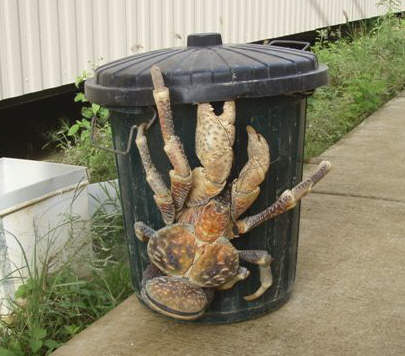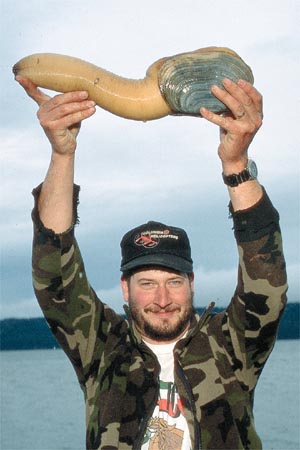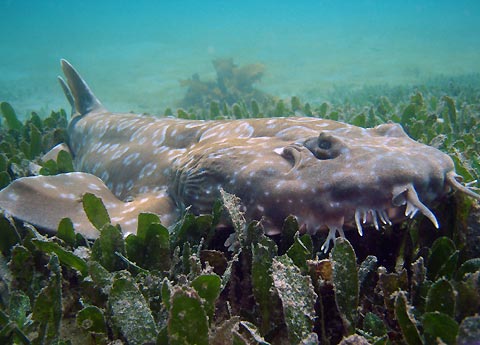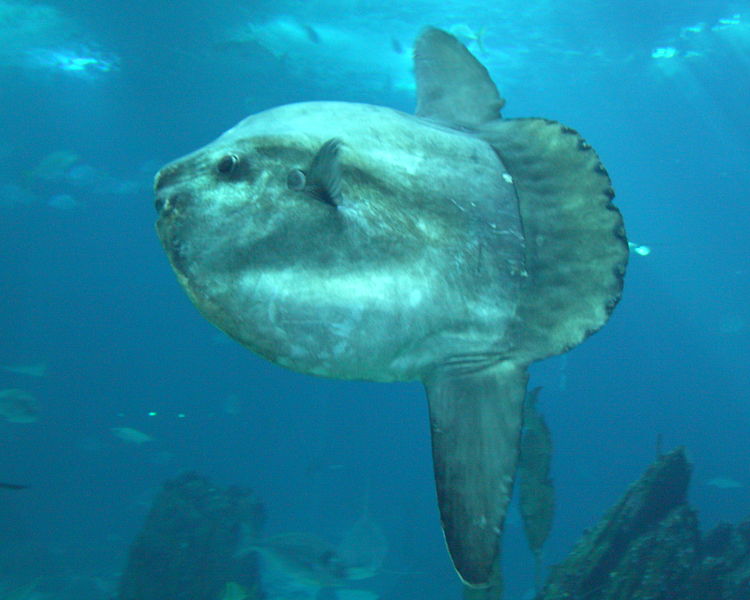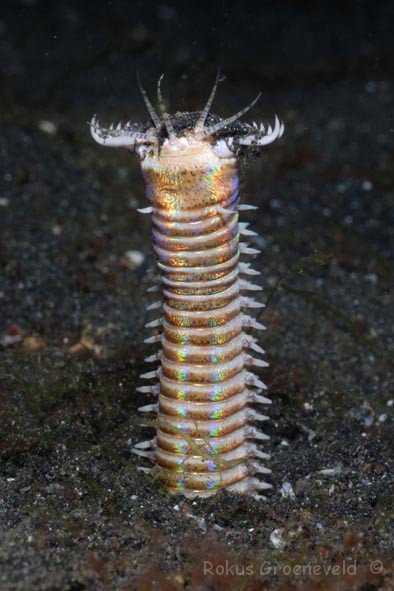Monday, May 31, 2010
May 31, 2010 : Dunkleosteus (Extinct)
Dunkleosteus
Dunkleosteus (From "(David) Dunkle" + osteus (οστεος, Greek: bone); meaning "Dunkle's Bone") is a prehistoric fish, one of the largest arthrodire placoderms ever to have lived, existing during the Late Devonian period, about 380-360 million years ago.
This hunter, measuring up to 10 metres (33 ft) and weighing 3.6 tonnes (4.0 short tons), was a hypercarnivorousapex predator. Few other placoderms, save, perhaps, its contemporary, Titanichthys, rivaled Dunkleosteus in size.
Dunkleosteus is a member of the pachyosteomorph arthrodires, and is more specifically usually placed in the family Dinichthyidae, a family composed mostly of large, carnivorous arthrodires like Gorgonichthys. Anderson (2009) suggests that because of its primitive jaw structure Dunkleosteus should be placed outside the family Dinichthyidae, perhaps close to the base of the clade Pachyosteomorpha, near Eastmanosteus, but this idea has yet to be tested.
This is the first extinct organism that will be appearing on the site. More will be featured periodically.
Sunday, May 30, 2010
May 30, 2010 : Toadfish
Toadfish
Toadfishes are usually scaleless, with eyes set high on large heads. Their mouths are also large, with both maxillapremaxilla, and often decorated with barbels and skin flaps. They are generally drab in colour, although those living coral reefs may have brighter patterns. They range in size from 7.5 centimetres (3.0 in) length in and Thlassophryne megalops, to 57 centimetres (22 in) in the Pacuna toadfish.
Toadfishes of the genus Porichthys, the midshipman fishes, have photophores and four lateral lines. All toadfishes possess sharp spines on the first dorsal fin and on the opercle (gill cover). In fish of the subfamily Thalassophryninae, these are hollow and connect to venom glands capable of delivering a painful wound to predators.
Saturday, May 29, 2010
May 29, 2010 : Seawolf
Seawolf
The Atlantic wolffish (Anarhichas lupus), also known as the Seawolf, Atlantic catfish, ocean catfish, wolf eel (the common name for its Pacific relative), or sea cat, is a marine fish, the largest of the wolffish family Anarhichadidae. The numbers of the Atlantic wolffish are rapidly depleting due to overfishing and by-catch, and is currently a Species of Concern according to the National Oceanic and Atmospheric Administration's (NOAA) National Marine Fisheries Service (NMFS). Although it is a fearsome looking creature, the Atlantic wolffish is only a threat when defending itself outside of the water. Apart from their unique appearance wolffish are also distinguished by the natural antifreeze they produce to keep their blood moving fluidly in their very cold habitat, involvement by both the male and female in brood bearing, and the large size of their eggs. They are also an important factor in controlling green crab and sea urchin populations, which can become overly disruptive to habitats if they are left unchecked. Wolffish population success is also an important indicator of the health of other bottom dweller populations, such as cod.
Friday, May 28, 2010
May 28, 2010 : Coconut Crab
Coconut Crab
The coconut crab, Birgus latro, is the largest land-living arthropod in the world, and is probably at the upper limit of how big terrestrial animals with exoskeletons can become in today's atmosphere. The species inhabits the coastal forest regions of many Indo-Pacific islands, although localized extinction has occurred where the crab is sympatric with man. Generally nocturnal, they remain hidden during the day and emerge only on some nights to forage. Their body is divided into four regions; the cephalic lobe, forepart, trunk, and opisthosoma. It is a highly apomorphic hermit crab and is known for its ability to crack coconuts with its strong pincers to eat the contents. It is the only species of the genus Birgus.
Thursday, May 27, 2010
May 27, 2010 : Stonefish
Stonefish
Synanceia is a genus of fish of the family Synanceiidae, the Stonefishes, whose members are venomous, dangerous, and even fatal to humans. It is the most venomous fish in the world. They are found in the coastal regions of Indo-Pacific oceans. They are primarily marine, though some species are known to live in rivers. Its species have potent neurotoxins secreted from glands at the base of their needle-like dorsal fin spines which stick up when disturbed or threatened. The vernacular name of the species, the stonefish, derives from being able to camouflage and transform itself to a gray and mottled color similar to the color of a stone. Divers have sometimes stepped on them, thinking they are stones.
Wednesday, May 26, 2010
May 26, 2010 : Coelacanth
Coelacanth
The coelacanths, which are related to lungfishes and tetrapods, were believed to have been extinct since the end of the Cretaceous period. The coelacanth is actually more related to tetrapods than the ray-finned fish. They were considered the "missing link" between the fish and the tetrapods until the first Latimeria specimen was found off the east coast of South Africa, off the Chalumna River in 1938.
The first specimen of this species was only photographed at a local market by Arnaz and Mark Erdmann before being bought by a shopper.
Tuesday, May 25, 2010
May 25, 2010 : Hairy Angler
Hairy Angler
The Hairy angler (Caulophryne polynema) is an ocean fish, and was first discovered by a BBC film crew while creating the documentary series The Blue Planet.
The female is about the size of a football and its body is covered in long antennae, which it uses to detect the movements of any prey nearby. The male is a tenth the size; about the size of a ping pong ball. The male also forms a parasitic relation with the female, attaching himself to her flesh and ultimately fusing with her blood stream.
Monday, May 24, 2010
May 24, 2010 : Geoduck
Geoduck
The geoduck (pronounced /ˈɡuː.iːdʌk/ "gooey duck"), Panopea generosa, is a species of very large saltwaterclam, a marine bivalve mollusk in the family Hiatellidae.
The shell of this clam is large and contains small wings, about 15 centimetres (5.9 in) to over 20 centimetres (7.9 in) in length, but the extremely long siphons make the clam itself very much longer than this: the "neck" or siphons alone can be 1 metre (3.3 ft) in length.
Sunday, May 23, 2010
May 23, 2010 : Wobbegong Shark
Wobbegong Shark
Wobbegong is the common name given to the 11 species of carpet sharks in the family Orectolobidae. They are found in shallow temperate and tropical waters of the western Pacific Ocean and eastern Indian Ocean, chiefly around Australia and Indonesia, although one species (the Japanese wobbegong, Orectolobus japonicus) occurs as far north as Japan. The word wobbegong is believed to come from an Australian Aboriginal language, meaning "shaggy beard", referring to the growths around the mouth of the shark of the western Pacific.
Saturday, May 22, 2010
May 22, 2010 : Blobfish
Blobfish
The blobfish (Psychrolutes marcidus) is a deep sea fish of the family Psychrolutidae. Inhabiting the deep waters off the coasts of mainland Australia and Tasmania, it is rarely seen by humans.
Blobfish live at depths where the pressure is several dozens of times higher than at sea level, which would likely make gas bladders inefficient for maintaining buoyancy. Instead, the flesh of the blobfish is primarily a gelatinous mass with a density slightly less than water; this allows the fish to float above the sea floor without expending energy on swimming. Its relative lack of muscle is not a disadvantage as it primarily swallows edible matter that floats by in front of it.
Blobfish can be caught by bottom trawling with nets. Such trawling in the waters off Australia may threaten the blobfish in what may be its only habitat.
Friday, May 21, 2010
May 21, 2010 : Grenadiers
Grenadiers
Grenadiers or rattails (less commonly whiptails) are generally large, brown to black gadiform marine fish of the family Macrouridae. Found at great depths from the Arctic to Antarctic, members of this family are among the most abundant of the deep-sea fishes.
The Macrouridae are a large and diverse family with some 34 genera and 383 species recognized (well over half of which are contained in just three genera, Caelorinchus, Coryphaenoides and Nezumia). They range in length from approximately 10 centimetres (3.9 in) in the graceful grenadier (Hymenocephalus gracilis) to 1.5 metres (4.9 ft) in the giant grenadier, Albatrossia pectoralis. An important commercial fishery exists for the larger species, such as the giant grenadier and roundnose grenadier, Coryphaenoides rupestris. The family as a whole may represent up to 15 percent of the deep-sea fish population.
Thursday, May 20, 2010
May 20, 2010 : Argonaut
Argonaut
The argonauts (genus Argonauta, the only extant genus in the Argonautidae family) are a group of pelagic octopuses. They are also called paper nautiluses, referring to the paper-thin shell that females secrete. This structure lacks the gas-filled chambers present in chambered nautilus shells and is not an inherited cephalopod shell, but rather an evolutionary innovation unique to the genus Argonauta. It is used as an eggcase and for trapped surface air to maintain buoyancy.
Video source here at Discover Magazine.
Wednesday, May 19, 2010
May 19, 2010 : Portuguese Man-o-War
Portuguese Man-o-War
The Portuguese Man o' War (Physalia physalis), also known as man of war, is a venomous marine invertebrate. The common name comes from a Portuguese war ship type of the 15th and 16th century, the caravel (in Portuguese, Caravela), which had triangular sails similar in outline to the bladder of the Portuguese Man o' War.
While the Portuguese Man o' War resembles a jellyfish, it is in fact a siphonophore – a colony of four kinds of minute, highly modified individuals, which are specialized polyps and medusoids. Each such zooid in these pelagic colonial hydroids or hydrozoans has a high degree of specialization and, although structurally similar to other solitary animals, are all attached to each other and physiologically integrated rather than living independently. Such zooids are specialized to such an extent that they lack the structures associated with other functions and are therefore dependent for survival on the others to do what the particular zooid cannot do by itself.
Tuesday, May 18, 2010
May 18, 2010 : Challenger Deep
The Trieste was a Swiss-designed deep-diving research bathyscaphe ("deep boat") with a crew of two, which reached a record-breaking depth of about 10,911 metres (35,797 ft), in the deepest known part of any ocean on Earth, the Challenger Deep in the Mariana Trench, on January 23, 1960.
Challenger Deep
The Challenger Deep is the deepest surveyed point in the oceans, with a depth of approximately 36,000 feet (11,000 meters). It is located at the southern end of the Mariana Trench near the Mariana Islands group. The Challenger Deep is a relatively small slot-shaped depression in the bottom of a considerably larger crescent-shaped trench, which itself is an unusually deep feature in the ocean floor.
The closest land to the Challenger Deep is Fais Island (one of the outer islands of Yap), 289 km (180 mi) southwest, and Guam, 306 km (190 mi) to the northeast. The depression is named after the British Royal Navy survey ship HMS Challenger, whose expedition of 1872–76 made the first recordings of its depth.
Related Articles : Mariana Trench
Monday, May 17, 2010
May 17, 2010 : Giant Tube Worm
Giant Tube Worm
They have a highly vascularized, red "plume" at the tip of their free end which is an organ for exchanging compounds with the environment (e.g., H2S, CO2, O2, etc). The tube worm does not have many predators, as few creatures live on the sea bottom at such depths. If threatened, the plume may be retracted into the worm's protective tube. The plume provides essential nutrients to bacteria living inside a specialized organ within its body (i.e., trophosome) as part of a symbiotic relationship. They are remarkable in that they have no digestive tract, but the bacteria (which may make up half of a worm's body weight) turn oxygen, hydrogen sulfide, carbon dioxide, etc. into organic molecules on which their host worms feed. This process, known as chemosynthesis, was first recognized by Colleen Cavanaugh while she was a graduate student at Harvard.
Sunday, May 16, 2010
May 16, 2010 : Goliath Grouper
Goliath Grouper
The goliath grouper is found primarily in shallow tropical waters among coral and artificial reefs at depths of up to 165 feet (50 m). Their range includes the Florida Keys, the Bahamas, most of the Caribbean, and practically all of the Brazilian coast, where they are known as mero. On some occasions it is caught in New England off Maine and Massachusetts but it is not that common. In the eastern Atlantic Ocean, it occurs from Congo to Senegal.
Young grouper may live in brackish estuaries, canals, and mangrove swamps, unusual behavior among grouper.
Saturday, May 15, 2010
May 15, 2010 : Predatory Tunicate
Predatory Tunicate
Predatory tunicates (Megalodicopia hians) are tunicates which live anchored along the deep sea canyon walls and seafloor, waiting for tiny animals to drift or swim into their hood-shaped mouths. Looking something like a cross between a jellyfish and a Venus Flytrap, its mouthlike hood is quick to close when a small animal drifts inside. Once the predatory tunicate catches a meal, it keeps its trap shut until it is ready to eat again. They are known to live in the Monterey Canyon at depths of 200-1,000 m (656-3,281 ft).
Friday, May 14, 2010
May 14, 2010 : Blue-Ringed Octopus
Blue-Ringed Octopus
The blue-ringed octopuses (genus Hapalochlaena) are three (or perhaps four) octopus species that live in tide pools in the Pacific Ocean, from Japan to Australia. Despite their small size and relatively docile nature, they are currently recognized as one of the world's most venomous animals. They can be recognized by their characteristic blue and black rings and yellowish skin. They hunt small crabs, hermit crabs, and shrimp, and may bite attackers, including humans, if provoked.
Thursday, May 13, 2010
May 13, 2010 : Tripod Fish
Tripod Fish
The tripod fish, Bathypterois grallator, is a bathypelagic (deep sea) fish named for the long extensions of its pelvic and lower caudal fins, on which it stands on the sea floor. The tripod fish is closely related to the smaller spiderfish (Bathypterois longifilis), which is similar in appearance and habits but smaller and with much shorter fin extensions; the two species are often found standing very near to one another on the ocean floor.
Wednesday, May 12, 2010
May 12, 2010 : Ocean Sunfish
Ocean Sunfish
The ocean sunfish, Mola mola, or common mola, is the heaviest known bony fish in the world. It has an average adult weight of 1,000 kg (2,200 lb). The species is native to tropical and temperate waters around the globe. It resembles a fish head with a tail, and its main body is flattened laterally. Sunfish can be as tall as they are long when their dorsal and ventral fins are extended.
Sunfish live on a diet that consists mainly of jellyfish, but because this diet is nutritionally poor, they consume large amounts in order to develop and maintain their great bulk. Females of the species can produce more eggs than any other known vertebrate. Sunfish fry resemble miniature pufferfish, with large pectoral fins, a tail fin and body spines uncharacteristic of adult sunfish.
Tuesday, May 11, 2010
May 11, 2010 : Stargazer
Stargazer
In addition to the top-mounted eyes, stargazers also have a large upward-facing mouth in a large head. Their usual habit is to bury themselves in sand, and leap upwards to ambush prey (benthic fish and invertebrates) that pass overhead. Some species have a worm-shaped lure growing out of the floor of the mouth, which they can wiggle to attract prey's attention. Both the dorsal and anal fins are relatively long; some lack dorsal spines. Lengths range from 18 cm up to 90 cm, for the giant stargazer Kathetostoma giganteum.
Stargazers are venomous; they have two large poison spines situated behind the opercle and above the pectoral fins. They can also cause electric shocks.
Monday, May 10, 2010
May 10, 2010 : Black Swallower
Black Swallower
The black swallower, Chiasmodon niger, is a species of deep sea fish in the family Chiasmodontidae, notable for its ability to swallow fish larger than itself (for which it is sometimes named the "great swallower"). It has a worldwide distribution in tropical and subtropical waters, in the mesopelagic and bathypelagic zones at a depth of 700-2,745 meters (2,300-9,000 ft).
Sunday, May 9, 2010
May 9, 2010 : Mariana Trench
The Mariana Trench
The Mariana Trench is the deepest known part of the world's oceans, and the lowest elevation of the surface of the Earth's crust. It is located in the western Pacific Ocean, to the east of the Mariana Islands. The trench is about 2,550 kilometres (1,580 mi) long but has a mean width of only 69 kilometres (43 mi). It reaches a maximum depth of about 10,916 metres (35,814 ft) at the Challenger Deep, a small slot-shaped valley in its floor, at its southern end.
Related Articles : Challenger Deep and source of graph
The Mariana Trench is the deepest known part of the world's oceans, and the lowest elevation of the surface of the Earth's crust. It is located in the western Pacific Ocean, to the east of the Mariana Islands. The trench is about 2,550 kilometres (1,580 mi) long but has a mean width of only 69 kilometres (43 mi). It reaches a maximum depth of about 10,916 metres (35,814 ft) at the Challenger Deep, a small slot-shaped valley in its floor, at its southern end.
Related Articles : Challenger Deep and source of graph
Saturday, May 8, 2010
May 8, 2010 : Pistol Shrimp
The gunshot noise was added for effect by the original program. However, this video has some interesting facts if you can stand the sound effects.
Pistol Shrimp
Alpheidae is a family of caridean snapping shrimp characterized by having asymmetrical claws, the larger of which is typically capable of producing a loud snapping sound. Other common names of these species include pistol shrimp or alpheid shrimp.
The family is diverse and worldwide in distribution, consisting of about 600 species within 38 or more genera. The two most prominent genera are Alpheus and Synalpheus, with species numbering well over 250 and 100, respectively. Most snapping shrimp dig burrows and are common inhabitants of coral reefs, submerged seagrass flats and oyster reefs. While most genera and species are found in tropical and temperate coastal and marine waters, Betaeus inhabits cold seas and Potamalpheops is found only in freshwater caves.
Friday, May 7, 2010
May 7, 2010 : Sea Salp
Sea Salp
A salp (plural salps; also salpa, plural salpae or salpas) is a barrel-shaped, free-floating tunicate. It moves by contracting, thus pumping water through its gelatinous body. The salp strains the pumped water through its internal feeding filters, feeding on phytoplankton that it sieves out of the water.
Salps are common in equatorial, temperate, and cold seas, where they can be seen at the surface, singly or in long, stringy colonies. The most abundant concentrations of salps are in the Southern Ocean (near Antarctica). Here they sometimes form enormous swarms, often in deep water, and are sometimes even more abundant than krill. Over the last century, while krill populations in the Southern Ocean have declined, salp populations appear to be increasing.
Thursday, May 6, 2010
May 6, 2010 : Bobbit Worm
Bobbit Worm
Eunice aphroditois, the Bobbit worm, is an aquatic predatory polychaete worm dwelling at the ocean floor at depths of approximately 10 metres (33 ft) to 40 metres (130 ft).
This organism buries its long body into an ocean bed composed of gravel, mud or corals, where it waits patiently for outside stimulus to reach one of its five antennae.
Armed with sharp teeth, it is known to attack with such speeds that its prey is sometimes sliced in half. Although the worm hunts for food, it is omnivorous.
Wednesday, May 5, 2010
May 5, 2010 : Cookiecutter Shark
Cookiecutter Shark
The name "cookiecutter shark" refers to its feeding habit of gouging round plugs, like a cookie cutter, out of larger animals. Marks made by cookiecutter sharks have been found on a wide variety of marine mammals and fishes, as well as on submarines, undersea cables, and even human bodies. It also consumes whole relatively smaller prey such as squid. Cookiecutter sharks have adaptations for hovering in the water column and likely rely on stealth and subterfuge to capture more active prey. Its dark collar seems to mimic the silhouette of a small fish, while the rest of its body blends into the downwelling light via its ventral photophores. When a would-be predator approaches the lure, the shark attaches itself using its suctorial lips and specialized pharynx and neatly excises a chunk of flesh using its bandsaw-like set of lower teeth. This species has been known to travel in schools.
Tuesday, May 4, 2010
May 4, 2010 : Slingjaw Wrasse
Slingjaw Wrasse
The slingjaw wrasse gets its name from its highly protrusible jaws, which can extend out to over half the fish's total body length. Unlike most other bony fishes, the lower jaw is not firmly attached to the skull. As a result, the slingjaw wrasse can project the upper and lower jaws simultaneously. This anatomical anomaly is employed to snatch shrimps, crabs and small fish out of narrow crevices and from between coral branches.
Monday, May 3, 2010
May 3, 2010 : Lion's Mane Jellyfish
Lion's Mane Jellyfish
The lion's mane jellyfish (Cyanea capillata) is the largest known species of jellyfish. Its range is confined to cold, boreal waters of the Arctic, northern Atlantic and northern Pacific Oceans, seldom found farther south than 42°N latitude. Similar jellyfish (which may be the same species) are known from the seas off Australia and New Zealand. The Arctic Lion's mane jellyfish is one of the longest known animals; the largest recorded specimen had a bell (body) with a diameter of 2.3 m (7 feet 6 inches) and tentacles 36.5 m (120 feet) long. It was found washed up on the shore of Massachusetts Bay in 1870. This specimen was longer than a blue whale, generally regarded as the largest animal on earth.
Sunday, May 2, 2010
May 2, 2010 : Japanese Spider Crab
Japanese Spider Crab
The Japanese spider crab has the greatest leg span of any arthropod, reaching 3.8 metres (12 ft 6 in) from claw to claw. The body may grow to a size of 40 centimetres or 16 in (carapace width) and the whole crab can weigh up to 41 pounds (19 kg). It is the males which have the longest chelipeds; females have much shorter chelipeds, which are shorter than the following pair of legs. Apart from its outstanding size, the Japanese spider crab differs from other crabs in a number of ways. The first pleopods of males are unusually twisted, and its larvae appear primitive. The crab is orange, with white spots along the legs. It is reported to have a gentle disposition "in spite of its ferocious appearance".
Saturday, May 1, 2010
May 1, 2010 : Symbion pandora
In the eastern Atlantic Ocean – on the mouthparts of Norway lobsters (also known as Dublin Bay prawns or langoustines)
There's no question that discovering a new species is very cool. But how about discovering a new phylum?
There's no question that discovering a new species is very cool. But how about discovering a new phylum?
A phylum is a broad division in taxonomy: all vertebrates, for example, from fish to humans, are in the chordate phylum. In 1995, Peter Funch and Reinhardt Møbjerg Kristensen, both then at the University of Copenhagen, Denmark, discovered an animal so unlike any other that a new phylum – Cycliophora – had to be created just for it.
Symbion pandora, as they called the new creature, is a tiny animal with a complex body and a bizarre life cycle. It still baffles biologists 15 years after it was formally described, and the latest work on its nervous system isn't helping matters.
Subscribe to:
Posts (Atom)




